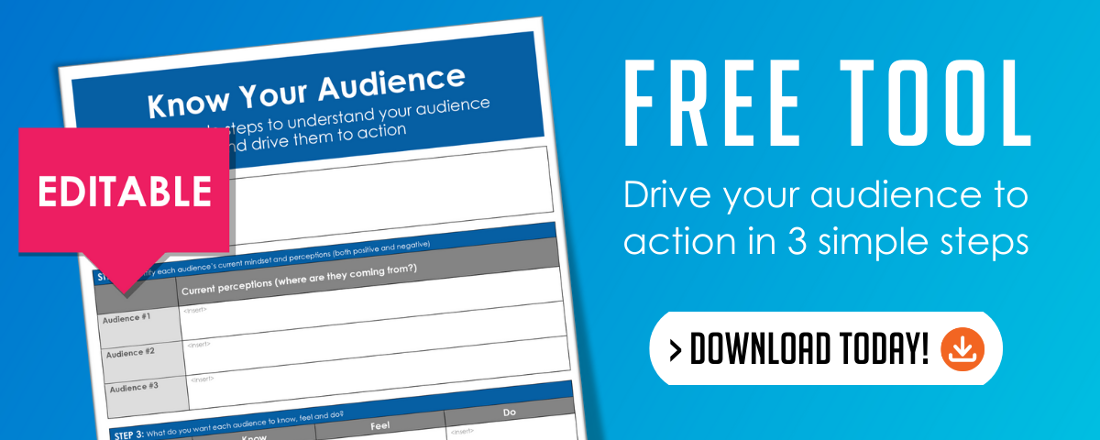
You’ve probably heard the philosophical question, “If a tree falls in a forest and no one is around to hear it, does it make a sound?” That same concept applies to communication. If you share a message with an audience and it doesn’t make sense to them or they aren’t able to connect with it, did they really hear what you had to say?
Where Effective Communication Begins
All effective communication begins with knowing your audience and speaking their language – both literally and figuratively. That doesn’t mean changing your core messages, but rather adjusting the way you present them or the context you offer to help explain those messages in a way that resonates most directly with the people to whom you are speaking. Sometimes that is much harder than it sounds because audiences can vary greatly, whether across a team or an entire organization. So where should you begin?
STEP 1: Determine who your audience is
You might start by making a list of the various groups that form your audience for an upcoming presentation or a memo that you’re writing. Don’t limit this list. Make sure you consider all aspects of your audience, including peers and those to whom you report, if that applies.
Think about the different segments of your audience and specifically:
- What they have in common
- Where they differ
- What level of knowledge about the topic they bring to the table (e.g., preconceived notions or lack of background that is relevant to the current topic).
STEP 2: Consider what is on their minds
Put yourself in their shoes and think about how they view your topic and what they care about. Ask yourself what they most want to know about the topic at hand and how it specifically relates to or interests them. Looking at the world through their eyes will help you develop an effective message and deliver it in ways that will make your audience more likely to listen, engage and act.
STEP 3: Think about what you need them to know
While it is absolutely critical that you adjust your messages and means of communication to your audience, that doesn’t mean you should lose sight of what you need them to know. Remember your core messages and make sure you are clearly and effectively incorporating them into your communication, while simultaneously packaging them in a way that will best meet your audience where they are.
STEP 4: Think about what you need them to know, feel or do based on what you tell them
More than just passing along information, effective communication should inform, engage, and inspire listeners or readers. Keep that in mind when you are crafting your next speech or memo. Ask yourself what you want the audience to remember as a result of what you have said. Are you calling them to take action of any kind? Is that “ask” clearly conveyed and repeated for emphasis? The most effective communication moves people to action, and many times we need to ask for what we want!
STEP 5: Decide the best means of communicating this information
As a child, we’re often reminded that “there’s a time and a place” for that (whatever the activity may be). That adage holds true for effective communication as well.
When considering setting and format, if you are sharing news about a major change, perhaps that is best done in a town hall or team meeting to allow for interactive dialogue. If you’re passing on regular updates that people need to know, but likely won’t elicit concern, then consider a memo or regular e-newsletter, depending on the channels you have available. The more complex the message, the more you need a setting or channel that allows for interaction.
STEP 6: Ask yourself how you can best relate to your audience and motivate them to take action
Now we’re getting down to the heart of knowing your audience. Look back at your audience list and their mindset. Think about a story that you could tell that they might relate to or a way you could relate back to how their actions will have a broader impact on the company as a whole. This is your chance to add relevancy to what you’re saying and leave them with a memorable call to action.
Ultimately, the key is knowing your audiences and presenting the information they want to hear along with the information they need to hear in a way that works best for them. When you think about message delivery in those terms, you’re setting up yourself and your audiences for a positive communications experience – no matter the topic you are conveying.
Which of these steps provide you the greatest opportunity to be more audience-focused?
—David Grossman
Before you can influence and move your audience to action, you have to understand what's important to them. Click below to download this fully editable Word document tool to help:


Comments on this post